Call Center Management: Challenges, Strategies, Tips, and Best Practices
In today’s time, setting up a call or contact center is extremely easy. But managing its day-to-day operations has become tougher as contemporary call center managers have to cope with several challenges including post-covid work scenarios, high attrition rate, increasing competition, and more.
In such time, the words of noted American business executive, chemical engineer, and writer Jack Welch ring true even after so many years. He famously said “Management is all about managing in the short term, while developing the plans for the long term.”
For customer service businesses, call/contact centers play an important role in driving sales, improving retention rates, delivering excellent customer service and ultimately enhancing their brand’s reach and achieving positive recognition.
As per a report by Gartner, companies that prioritize customer satisfaction with growth, margin, and profitability are more likely to experience customer successes, and have 29% higher chance of securing CX budgets.
At HoduSoft, we strongly believe that call centers and contact centers should do whatever it takes to manage their daily operations as efficiently and effectively as possible. The way a call center is managed goes a long way in determining its success or failure.
In this blog, we have highlighted how call center management can be made seamless using call center software or contact center software while tracking essential metrics and executing standard call center management practices. Let’s get started!
- An understanding of call center management
- How does a call center work?
- Different types of call/contact center professionals
- What are the key skills of call or contact center professionals?
- Why do businesses need call center management?
- Key components of call center management
- Key metrics to evaluate the success of call center management
- Challenges in call center management
- Best practices for efficient call center management
- Trends in call center management
An Understanding of Call Center Management
What is Call Center Management?
Call center management is a process using which businesses manage the daily operations of their call centers.
It encompasses everything from forecasting, hiring employees, agent training and coaching, workforce scheduling, professional handling of customer contacts, and many more. Call centers are a fast-paced environment, where the leaders or managers need to manage plenty of employees, processes, and tasks to ensure effective collaboration, increased productivity, streamlined workflows, and efficient handling of customer contacts.
By leveraging the best tools and practices of call center management, call centers can achieve their desired goals effortlessly.
Before going into the details of call center management, let’s see how a call center works, who are call center professionals and their key skills.
How Does a Call Center Work?
A call center and contact centers handle customer communication via multiple channels such as phone calls, emails, live chat, social media, and more. Let’s dive deep into the workings of a call/contact center.
1. Inbound Communication
Call and Contact centers receive a wide range of incoming communication requests such as:
- Inquiries about products or services
- Customer complaints
- Requests for technical support
- Requests for placing orders and more
2. Outbound Communication
Some also make outbound communication such as:
- Making sales calls
- Following up on customer inquiries
- Conducting surveys
- Providing proactive support
3. Omnichannel Experience
Contemporary contact centers provide omnichannel experience. The channels typically comprise:
- Phone calls
- Emails
- Live chat
- Social media platforms
- SMS/text messaging
- Video calls
4. Customer Relationship Management (CRM) Integration
Call and Contact center agents often use CRM software to access:
- Customer information
- Previous interactions
- Purchase history
- Other relevant data
This helps agents provide personalized assistance and streamline communication.
Different Types of Call/Contact Center Professionals
In an average call/contact center, there are three types of contact center professionals and they are:
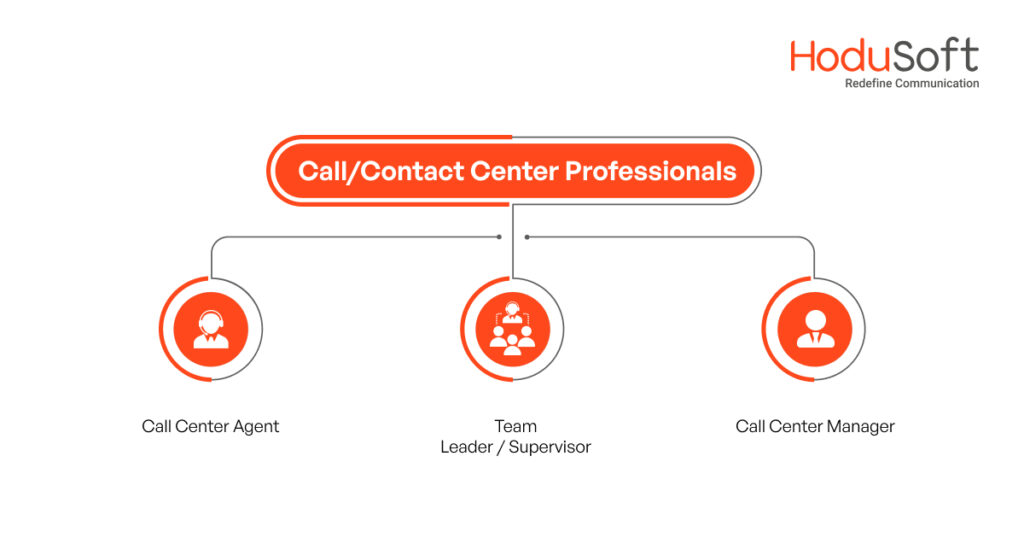
Call/Contact Center Manager
As the name makes it extremely clear, a call/contact center manager is a professional who manages a call/contact center. To define a call/contact center manager in a more fun and engaging way, let’s cite an example from popular culture.
If you have watched the 2006 Hollywood movie (or its 2010 adaptation) ‘Outsourced’ then Todd Anderson (or Todd Dempsy, in the series) is the closest and the best example of a call center manager. Smart, sharp, friendly, compassionate, and result-oriented, he manages his call center quite efficiently.
The key responsibilities of a call center manager are to develop and implement the overall strategy for the call center, make key decisions, prepare budget and manage resources, provide direction and leadership, interact with stakeholders, just to name a few.
Call/Contact Center Supervisor
As the name suggests, a call or contact center supervisor is a professional who supervises call center’s operations as well as the performance of agents. The professional reports to the manager about the overall performance of the agents and call center.
The key responsibilities of a call center supervisor are to manage the call center agents and other team members, monitor performance, resolve problems, provide training and guidance, and assist in day-to-day operations.
If we have Todd from ‘Outsourced’ as the perfect example of a call center manager, then we have Rajiv from the series as a not-so-perfect example of a call center supervisor.
Call/Contact Center Agent
This one is self-explanatory. If you have ever contacted a business, then you must know the people who respond to your query or concern are call/contact center agents. A call center agent, also known as a call center representative, is an employee who handles all incoming and outgoing interactions.
The roles and responsibilities of a call center agent are much more than interacting with customers and handling their queries. Some of the responsibilities of call center agents include creating tickets or cases, reports, templates, as well as taking follow-up actions.
What Are the Key Skills of Call or Contact Center Professionals?
Whether it’s call/contact center managers, supervisors, or agents, all professionals engaged in the industry must have (or acquire) some key skills such as:
1. Excellent Understanding of Customer Service
Call or Contact center professionals not only need to understand customers but also their pain points, what solutions they expect from every call they make, and what makes customer service effective. Once they understand all these, nothing can stop them from delivering exceptional customer service.
2. Effective Communication
Effective communication is at the heart of effective customer service. Those call/contact center professionals who understand the power of effective communication succeed in delivering exceptional customer service.
3. Emotional Intelligence
It is extremely crucial for call center professionals to have emotional quotient (EQ), which is also known as emotional intelligence. Even though some people are blessed with higher emotional intelligence from birth, the good news is anyone can increase their EQ with a little bit of effort, practice, and connection.
4. Problem-Solving Skills
The call center industry is one of the most fast-paced and dynamic industries than many other sectors. In such an industry, nothing is unexpected and employees must be prepared for all eventualities. Professionals who work in the industry experience many new challenges and they must sharpen their ability to solve problems as they arise. As the call and contact center industry is extremely fast-paced, agents must be able to think on their feet. Like EQ, problem-solving abilities can be honed and mastered.
Why Do Businesses Need Call Center Management?
Call center management plays a significant role in determining business efficiency and customer service quality. An effective call center management results in satisfied and happy employees, greater productivity, and happier customers. Here are some reasons why businesses need call or contact center management:
1. Customer Service Excellence
What legendary philosopher Aristotle said about excellence is so apt for well-managed call centers. “We are what we repeatedly do. Excellence, then, is not an act but a habit.” When call centers and contact centers are managed well, they report higher customer service excellence as they are able to deliver superior customer service as well as customer satisfaction.
2. Operational Efficiency
Successful call/contact centers are extremely efficient and score high in operational efficiency. When contact center managers, supervisors, and agents work in a concerted manner, they are not only able to increase productivity by leaps and bounds but also minimize wastage of resources.
3. Cost Management
Would you be surprised to know that well-managed call centers are able to optimize their costs and other resources available at their disposal? That’s what effective management is all about. Effective call center management not only manage to control their expenses as they improve service quality but also succeed in meeting their budget allocations and negotiating favorable contracts with vendors.
4. Data-Driven Insights
Call/Contact centers that are managed professionally are able to leverage data analytics to their advantage and make data-driven decisions. They are also better able to project customer behavior, preferences, and trends. All these valuable data-driven insights help agents to tailor their interactions with customers and optimize their overall performance.
Key Components of Call Center Management
When it comes to making a call or contact center successful, many factors play a huge role in making that happen. Some of them are:
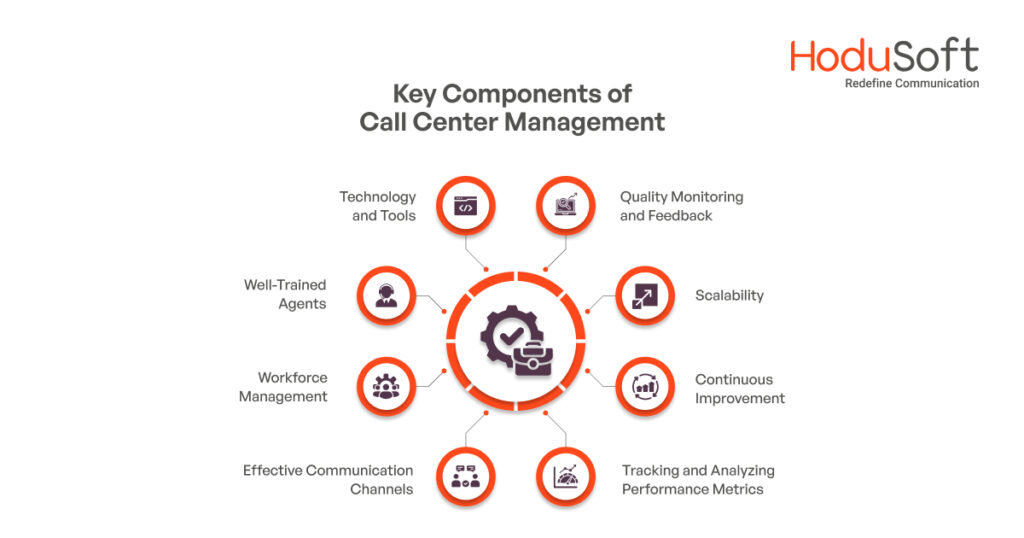
1. Effective Communication Channels
First thing first, communication channels play a huge role in determining the success of any modern day call/contact center. A successful contact center provides an omnichannel experience to its customers by providing various communication channels such as phone, email, chat, and social media to ensure that customers can reach the contact center through their preferred channel.
2. Workforce Management
Workforce management in a call center is all about ensuring the right amount of agents with the anticipated call volume to improve operational efficiency and service levels. It is a process that involves forecasting, scheduling, and real-time adjustments to ensure adequate staffing. Effective workforce management not only reduces costs but also enhances customer service standards.
3. Well-Trained Agents
The success of a call or contact center immensely depends upon how well-trained its agents are. If its agents have received adequate training, the probability of the call/contact center’s success increases manifold.
4. Technology and Tools
The integration of advanced technology and tools is critical for today’s call centers and contact centers to ensure better efficiency and service quality. Integration of technologies like CRM systems, advanced dialers, automated call distribution, automation tools, chatbots, IVR systems, voice transcription, speech analytics, and others not only improves agent productivity but also provides valuable data for analytics and decision-making.
5. Quality Monitoring and Feedback
“What gets measured gets managed.” “Feedback is the breakfast of champions.” These two quotes pretty much sum up the necessity of regular monitoring and feedback. Quality assurance in a call center often involves thoroughly monitoring and evaluating agent performance. By reviewing call recordings, providing feedback, and implementing training programs, call centers can easily determine their strengths and areas for improvement, fostering a culture of continuous development.
6. Scalability
Scalability is the hallmark of every successful business. A successful contact center should be able to scale its operations to meet changing demand, whether it’s due to seasonal fluctuations or business growth. A scalable call/contact center that can seamlessly adjust its resources and capabilities as the organization evolves, can easily handle increasing call volumes and customer interactions without compromising on service quality.
7. Tracking and Analyzing Performance Metrics
Tracking and analyzing Key Performance Indicators (KPIs) like Average Handling Time (AHT), First Call Resolution (FCR), and Customer Satisfaction (CSAT), is vital for measuring call center effectiveness. These KPIs help management in identifying trends, industry standards, and implanting required solutions for improving the overall call center performance.
8. Continuous Improvement
Embracing a culture of continuous improvement encourages innovation and allows call/contact centers to adapt to evolving customer needs and industry trends. When contact centers are managed well, they relentlessly focus on new frontiers to improve and take their performance to the next level.
Key Metrics to Evaluate the Success of Call Center Management
Monitoring the right metrics in call center operations promotes precision and growth. Such metrics help businesses identify agents’ strengths and weaknesses and work on specific areas for maintaining a better customer experience. Let’s unwrap some useful call center metrics that provide deep insights about consumer interaction and can be leveraged by businesses to improve CX.
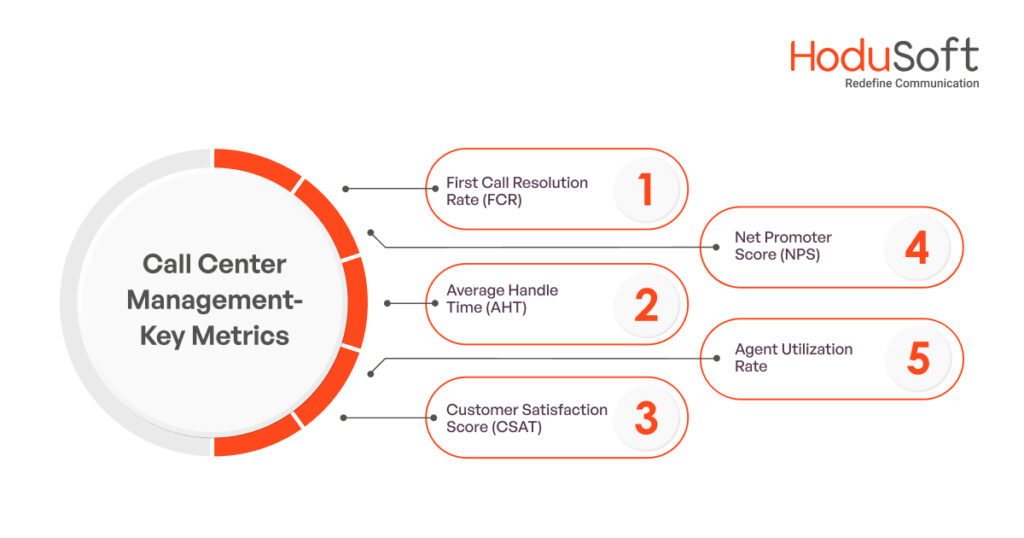
1. First Call Resolution Rate (FCR)
First Call Resolution Rate (FCR) refers to the successful resolution of a customer query within their first call without any follow-up, such as transferring, escalating, pausing, holding, or disconnecting the call. It shows how efficient the call/contact center operations are in solving customer issues.
Customers may feel frustrated if they have to call back multiple times to get their answers, creating an unsatisfied customer experience and impacting the brand’s reputation. Therefore, FCR becomes a crucial metric for customer relationship management. It is an excellent way to assess call center operations and agent effectiveness.
A call center’s FCR metrics can be improved in multiple ways, such as:
- Establishing a resourceful and knowledgeable base for FCR escalations
- Providing self-service options like IVR to resolve simple issues
- Allocating feedback by conducting surveys
- Tracking repeat calls through speech recognition
- Examining the FCR push-down cause
2. Average Handle Time (AHT)
Average Handle Time refers to the average time spent by agents to handle or manage a call from start to end. It also measures customer hold times and the time required for post-call tasks and administrative work (such as filing a form or updating the CRM).
According to Call Centre Magazine, the global industry benchmark for AHT (regardless of industry and team size) is six minutes and three seconds.
In most cases, businesses should have lower AHT. Although too low, AHT signals about some ongoing nuisance operations. For instance, if an agent deals with an angry customer who opts to stop the service. Having a fear in mind that his AHT would shoot up, the agent would immediately accept the customer’s request.
Imagine if agents won’t take the stress of maintaining low AHT. They would spend more time on calls and manage to calm the customers by successfully addressing their concerns.
Thus, this metric is very helpful in organizing team benchmarks and determining agents who need more training to serve customers better. It also helps to reveal issues beyond agent capability, such as complex workflow or obsolete technology experiences.
There are several ways businesses can follow to reduce their AHT:
- FAQs automation
- Recording & Reviewing phone calls
- Giving more emphasis on agent training
- Using IVR technology
3. Customer Satisfaction Score (CSAT)
CSAT is an essential metric for measuring customer satisfaction with businesses. It gives an overall score of customers’ happiness with using a brand’s product and dealing with its customer service.
A business CSAT score should always rise as it signifies an excellent customer experience. It positively impacts the business’s revenue generation as happy customers are more likely to recommend the service to others.
CSAT scores are calculated using simple survey results based on customer experiences. Businesses can ask their customers to rate their satisfaction experience with a particular agent interaction. Companies can use these scores to get insights into their operations and opt for steps to improve them.
Although CSAT scores depend on various factors, there are ways to improve them.
- Working on customer feedback
- Implementing multi-channel support
- Improving products and services
4. Net Promoter Score (NPS)
Net Promoter Score (NPS) is a metric that precisely tells about a customer’s interest in a brand. It enables businesses to gauge their customer’s trust and loyalty.
A scale from 0-10 is used to ask: “How likely or unlikely are you to recommend our company to your friends and peers?” The business promoters will score between 9-10, whereas passives and detractors would suggest a score of 7-8 and 0-6. As with other customer experience metrics, a high NPS score means a delighted customer who is satisfied with the customer experience.
Tips for businesses to foster a high NPS score:
- Work on the customer automation journey
- Increase the customer response time
- Retain customers through live engagement
5. Agent Utilization Rate
Agent utilization rate is the average time agents spend managing calls within a specific time to the total number of work hours. This metric gives a detailed analysis of the utilized time by the agents across their shifts. It is an excellent indicator to track the agent’s performance and monitor their schedule adherence.
The ideal agent utilization rate varies across industries and call types. Businesses need to fix standard utilization rates for their call center. Once accomplished, it can be an excellent tool for allocating goals for enhanced agent performance.
Ways to improve business agent utilization rates:
- Implementing practices for visual assistance
- Working on agent training
- Enabling a collaborative work environment
Challenges in Call Center Management
As mentioned above in the blog, setting up a call or contact center is extremely easy but managing its day-to-day operations is tougher as modern call centers have to face several challenges. Some of the key challenges that can impact overall efficiency and service quality of call/contact centers include-
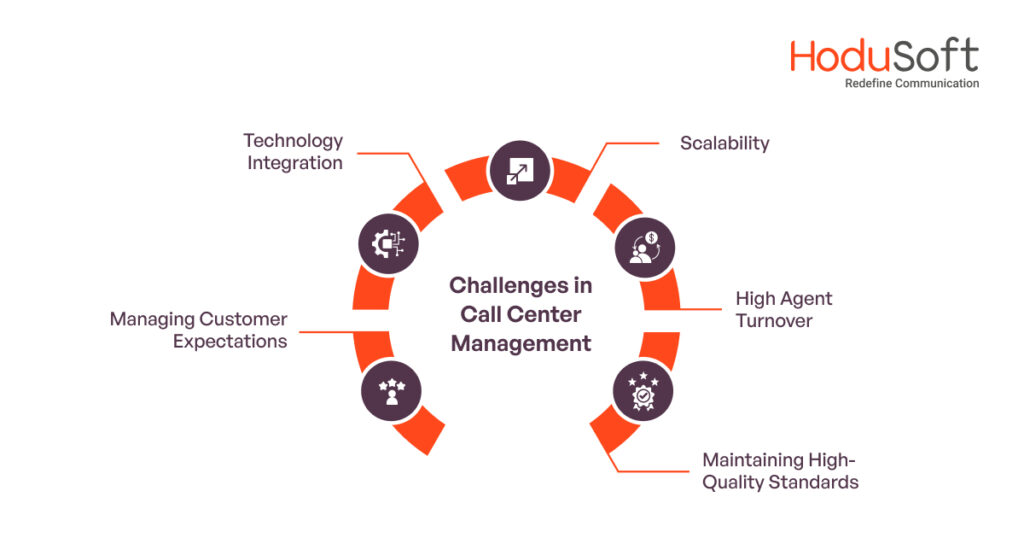
High Agent Turnover
High agent turnover is one of the most common challenges faced by call centers. It is often the result of factors like inadequate agent training, no flexibility, job stress, limited growth opportunity, etc. The impacts of high agent turnover are significant, including loss of skilled & experienced staff, failure to meet potential deadlines in service quality, increased costs for hiring and training new agents.
Maintaining High-Quality Standards
Another significant challenge in call center management is balancing efficiency with high-quality service. In order to remain competitive, it is essential for call centers to manage a high volume of calls quickly while ensuring satisfactory customer interactions. In simple words, call/contact centers must meet customer expectations while maintaining high service standards. With regular agent training and robust quality assurance processes, this balance can be achieved.
Technology Integration
Integrating advanced technologies can also have substantial challenges, especially when dealing with legacy systems. Systems that are outdated may not be able to support modern functionality, resulting in inefficiencies. It requires careful planning and execution to ensure seamless integration of advanced tools such as AI-driven chatbots, CRM systems, and analytics platforms. By improving service delivery efficiency and effectiveness, this integration enhances productivity and improves customer experience.
Scalability
Growing a call center requires scalability. As call volumes increase and teams expand, processes and infrastructure must be adapted to handle the larger scale without compromising service quality. To effectively manage growth, call centers should implement scalable solutions, such as cloud-based technologies and flexible staffing models. Planning and allocating resources strategically are key to ensuring that the call center can expand smoothly and continue to meet customer demands.
Managing Customer Expectations
In today’s time, managing and meeting customer expectations has become a critical factor, especially for customer service organizations. Customers these days expect fast, efficient, and omnichannel communication. In order to build trust and satisfaction, organizations must implement strategies to reduce wait times, improve service capabilities, and ensure proactive support.
The challenges in call center management are numerous, but with strategic planning and effective solutions, they can be successfully navigated. Addressing these challenges is key to the successful management and growth of a call center.
Best Practices for Efficient Call Center Management
As the metrics help evaluate your agents’ performance, there are a few standard practices that can uplift the efficacy of your contact center management.
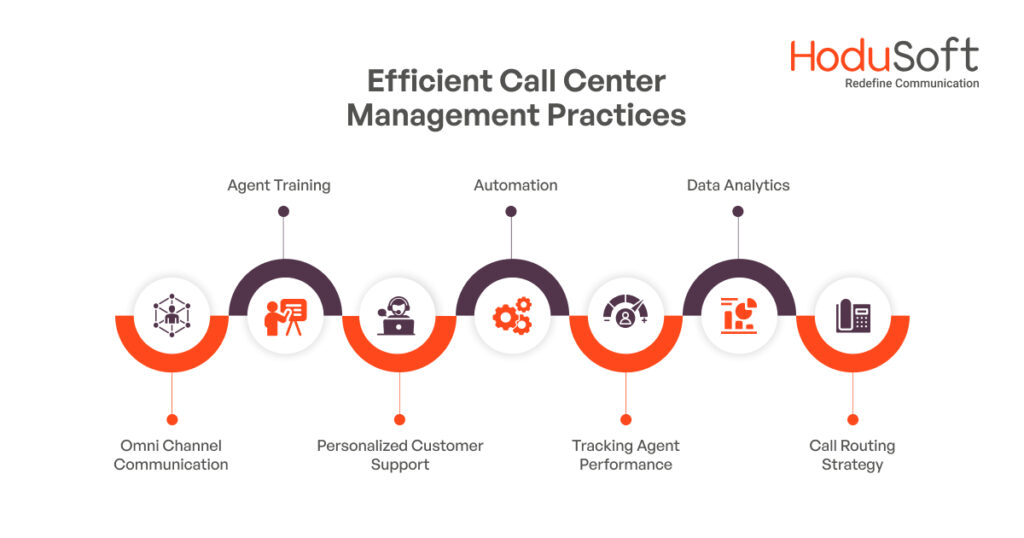
1. Adapting Omni channel Communication
Did you know that eight out of every ten customers expect the same level of service across all channels? This expectation can be fulfilled when businesses adapt Omni channel call center solutions. Omnichannel communication is not restricted to just opening up multiple channels for customer interaction. It also involves providing consistent service across all these channels. Moreover, as it integrates communication into a unified platform, managing such communication becomes easier for agents.
2. Delivering Personalized Customer Support
Modern customers dislike brands that offer a standard proposition for all their customers. More than 80% of customers are willing to purchase from brands that provide them with personalized experiences. Utilizing call centers software features like CRM integration and data analytics, businesses can understand the unique needs of every customer. It equips agents with customer insights to approach them with a personal touch. Customers who receive personalized service are more likely to refer the brand to their acquaintances. Moreover, it positively impacts metrics like FCR, conversion rate, and list closure rate, indicating improved call center management.
3. Implementing a Call Routing Strategy
When customers reach out to a business for a specific concern, it is essential to provide them with a quick resolution. But if a business does not have a call routing strategy, the customer may have to get through the hassle of multiple transfers and long waiting times. Adapting a skill-based call routing strategy can eliminate the customer frustration built during such instances. It directs the call to the agent with the matching skill set to resolve the issue. Therefore, it provides customers with a positive experience and also uplifts FCR. It also reduces the call abandonment rate by eliminating prolonged holding time.
Read More: Top Call Routing Strategies to Improve Customer Experience
4. Tracking Agent Performance
Call center management can be flawless only when agents are empowered with the right tools to perform efficiently. Call center software aids agents with tools like autodialer, call transfer, call bridging, etc., to enhance their productivity. Moreover, the agent dashboard lets them see their performance assessed based on different KPIs. When businesses track agent performance through live call monitoring, they can assure service quality compliance and back up agents under challenging situations.
5. Identifying Agent Training Needs
Did you know that inadequate training is one of the major factors responsible for high attrition rate in the call and contact center industry? Yes, as per a study, inadequate training is the major culprit behind the contact center industry’s high employee attrition rate of 20-30 percent. That’s not all, another data found 83 percent of high-performing agents say they get the required training to do their job well compared to only 52 percent of underperformers. When agents are trained with the skills they were lagging in, businesses can enjoy more engaged agents. It also ensures greater business productivity.
6. Detecting repetitions to implement automation
Call center management seems complex owing to the daily tasks. The number of tasks to be managed manually can be reduced by implementing workflow automation for mundane, repetitive tasks. Call center software aids businesses by automating tasks like contact management, data entry, and call routing. Businesses can optimize human resource allocation when specific tasks unburden them through automation.
7. Relying on data analytics for decision-making
Data has become the backbone of businesses. But analyzing large volumes of data to prepare impactful reports manually is a complicated and time-consuming chore. Call center software eases the process by automatically gathering and analyzing data to prepare reports comprising actionable insights. Such reports can be the foundation for building successful strategies for different business areas such as operations, marketing, sales, etc.
Trends in Call Center Management
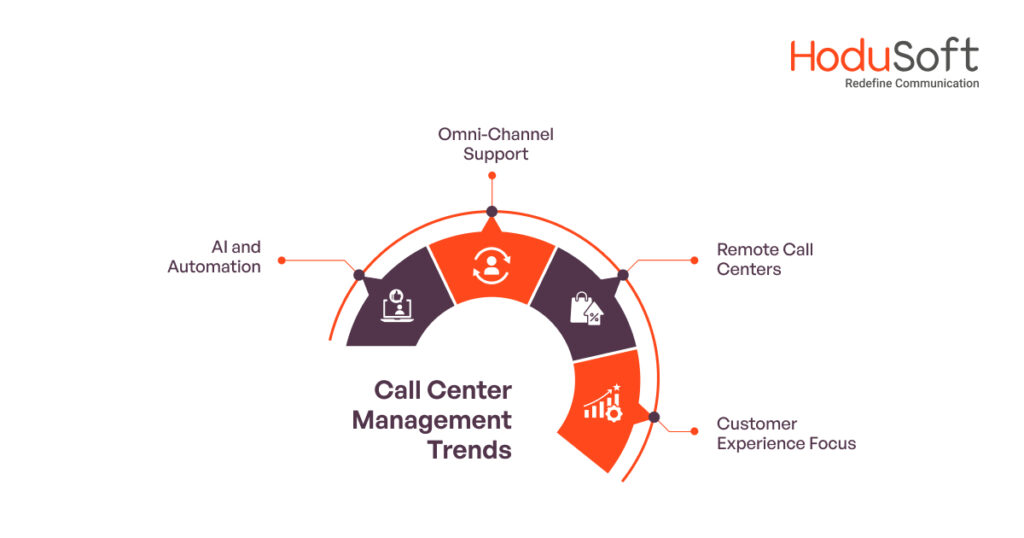
AI and Automation
AI and automation is transforming the industry by handling routine tasks and offering data driven insights. Using these tools like Chatbots, predictive analytics, voice recognition systems, and others, organizations can not only enhance their efficiency but also reduce operational costs greatly. Some of the key impacts of AI and automation tools on call centers include-
- Reduced wait times
- Enhanced service accuracy
- Streamlined processes
- Boosts the overall customer experience
Omni-Channel Support
Omni-channel support simply involves integrating diverse communication channels such as phone, email, chat, and social media into a single platform. When callers can reach the customer care representatives via their preferred channel, it leads to a cohesive and seamless customer experience. In all, integrating multiple channels helps ensuring-
- Seamless switching between channels without disruption
- Increased customer satisfaction and loyalty
- Unified customer experience
Remote Call Centers
From the past few years, the rise of remote and virtual call centers has become more common. Implementing remote work culture helps organizations in leveraging the benefits of a global talent pool and maintain flexibility. However, maintaining remote teams effectively can be a challenging task for the organizations. Here are some of the key ways to maintain remote teams effectively-
- Implementing robust communication tools
- Setting clear performance metrics
- Offering the right tools and technology to ensures team productivity & quality service
Customer Experience Focus
The shift towards an increasing emphasis on customer experience (CX) in call center operations has emerged as a significant trend reshaping the industry. However, ensuring call center services meet and exceed customer expectations is a challenging task. By analyzing customer data, call centers agents can customize their interactions and offer proactive solutions, thereby enhancing the overall customer experience. Customer experience techniques generally include-
- Offering personalized service
- Leveraging advanced technologies such as AI and data analytics
- Collecting and analyzing feedback to enhance service quality
- Using customer feedback to drive improvements
Conclusion:
Taking Everything into Account, call center management plays a critical role in customer success, operational excellence, regulatory compliance, and strategic decision-making within organizations.
Those businesses that focus on providing high-quality customer service and leave no stone unturned in managing their call/contact center operations are able to delight their customers and enjoy greater customer retention rate.
More often than not, leveraging the right call center software and contact center software can go a long way in managing a contact center efficiently and effectively.
If you are an owner of a contact center and are looking for solutions to manage your contact center in the best possible manner, we at HoduSoft happen to have just the right tools for you.



